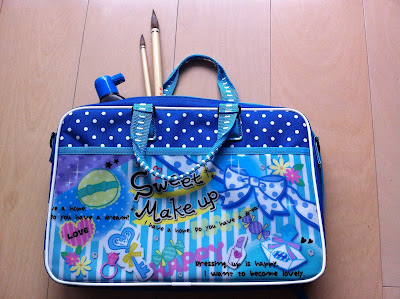Isn't it a pretty & colourful bag!
Can you guess what are in it?!
Brushes and a bottle?!Yes! It is a bag for 'Shuji', Japanese calligraphy, bag for kids at school.
When children who go to a local Japanese primary school, they are asked to have a set of 'Shuji' as below when they reach Year 3, ages of 8 and 9.
There are large and small brushes, 'bunchin' (paperweight), 'mizusashi' (water bottle), 'sumi' stick (sumi ink), 'bokuju' (liquid sumi ink), and 'suzuri' (ink stone).
There are two ways of what are called Japanese calligraphy, 'shuji' (習字) and 'shodo' (書道).
Many people may think they have almost the same meaning, 'shuji' for children and 'shodo' for adults.
But it is INcorrect!
'Shuji' is to write the words correctly and beautifully by copying the calligraphic samples. On the other hand, 'shodo' is a type of art that people express the artistic skills in calligraphy, ''the way of writing''.
Children who go to a Japanese primary school learn 'shuji' but 'shodo'.
It solved my question why children learn 'shodo' in Japanese literacy class but in art.
For 'shuji' set for children, the price range is from 2,500 yen to 3,500 yen depending the quality of brushes, 'sumi' stick, etc.
Looking at the differences in old and new 'shuji' bags, 'suzuri' is downgraded from stone to plastic, 'bunchin' is changed from one piece silver metal to two blue bars.
More surprisingly, it was common that 'shuji' bag was one plain colour, red for girls and black for boys.
Nowadays, it reflects the Japanese 'kawaii' (cute) culture even to the traditional Japanese calligraphy.
'Sweet Make-up'???! for Japanese cultural art?!
How do you see it!?
Y★


